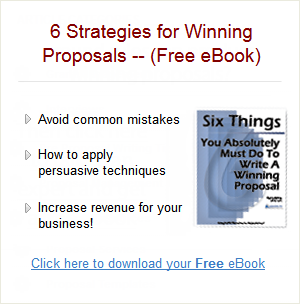One of the Biggest Mistakes Made in The Proposal Process
Every proposal gets reviewed. Too often, however, it only gets reviewed once, and at the end of the process, just before it goes out the door. This leaves no time to improve, and the quality will invariably suffer.
What does your review process look like?
You often prepare the proposal under so much time pressure that it may only get only get a thorough review at the end of the process, at the last moment before sending the proposal to the customer. And it may not be a thorough review at all, just a cursory glance to make sure all the pages are in the right order and nothing is missing.
| Here are two approaches to the review process–the typical and the recommended. |
Leaving reviews until the end of the process is a BIG mistake. This approach leads to some potentially significant problems:
- Themes are not checked to make sure they have been incorporated into all the appropriate sections.
- Without enough time, weak sections have no chance of being strengthened.
- Key RFP requirements are likely missed.
- If sections need major re-writing at the last minute the chances are good they won’t be well written. In addition, writing them will take a good deal of midnight oil burning (thus a lot of overtime).
- If sections are so weak you have to re-write them from the ground up all the time, effort and money spent writing them in the first place will have been wasted. This is the single biggest cause of proposals costing more than they need to.
If you find major errors chances are a lot of the proposal will have to be rewritten. And if you rewrite one section, you have to be aware of the ripple effect; if things change in one section, it could change things in other sections as well. This means a lot of rewriting, at a time when everyone is exhausted and sick to death of the job. A last minute rewrite usually means lots of errors.
The writing process, like any other, needs Quality Control.
That means the writing should be checked along the way, before it goes on long enough to make rewrites time consuming and costly. This means taking a look at the writing/reviewing process differently than you may have in the past.
After the first draft, the proposal leader and the proposal team should review the draft. The proposal leader is looking to make sure that the main proposal message–the “why our approach is best” theme–is clearly called out in all the sections.
She’s also reading to see that the writers have stayed on the right course. One of the biggest challenges of any proposal effort is keeping the writers on track. If they do get off on a tangent. it’s a lot easier for the proposal leader to catch it at this early stage and make a mid-course correction–get the writer to focus on the relevant information.
And sometimes the writer has gone off in a direction the proposal leader hadn’t seen, and is actually adding value to the proposal. If that’s the case, the proposal leader can include that into his overall plan, and make the necessary suggestions to other writers to include in their sections.
The team reads the first draft to see how their sections fit with the rest of the proposal. This is valuable; they learn that their small piece is actually an integral part of a uniform whole. Plus, it gives team members a chance to compare their writing to their colleagues; this often improves the quality of even the weakest writers.
After this review, the team prepares a second draft of the proposal. This draft is subject to the most important review of all, the Red Team Review. This activity is so important, it requires a full article all its own. Look for it in the next issue of Proposal Writing Tips& Techniques.
If this sounds like a lot of reviewing, it is. But it is not redundant, and contrary to what you might think, it does not add more time to the process. If you don’t review in stages like this, chances are you will spend the same amount of time—or more—at the end of the process rewriting sections. And this approach has the advantage of ensuring that your proposal addresses all the solicitation requirements, includes the themes, is technically accurate, and meets whatever page limitations the client has imposed.

